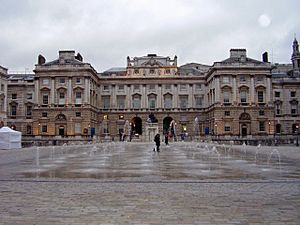Samuel Courtauld (art collector) facts for kids
Quick facts for kids
Samuel Courtauld
|
|
|---|---|
| Born | 7 May 1876 |
| Died | 1 December 1947 (aged 71) |
| Nationality | British |
| Occupation | Industrialist |
| Known for | Art Collector, Founder of Courtauld Institute |
| Spouse(s) | Elizabeth Theresa Frances Kelsey (known as Lil) |
| Parent(s) | Sydney Courtauld and Sarah Lucy Sharpe |
| Relatives | Stephen Courtauld (brother) Catharine Dowman (sister) |
Samuel Courtauld (born May 7, 1876 – died December 1, 1947) was a British businessman and a famous art collector. He is best known for starting The Courtauld Institute of Art in London in 1932. He also gave his amazing art collection to the institute when he passed away.
The Courtauld family business became a big international company in the early 1900s. They were very successful with rayon, a new artificial fabric that was a cheaper alternative to silk. Samuel Courtauld led the company as a director from 1908 and then as chairman from 1921 to 1946.
Contents
Early Life and His Love for Art
Samuel was the son of Sydney Courtauld and Sarah Lucy Sharpe. He went to Rugby School. After school, he visited Germany and France to study how textiles were made. This helped him prepare to work in his family's business. In 1901, he became a director at one of their factories in Halstead, Essex. By 1908, he was the chief executive officer (CEO) for all the company's factories.
Samuel became interested in art after seeing a collection at the Tate Gallery in 1917. But his journey as a serious art collector truly began in 1922. This was after he saw an exhibition of French art at the Burlington Fine Arts Club.
Collecting French Masterpieces
Samuel Courtauld was one of the first British collectors to be interested in French Impressionist and Post-Impressionist paintings. During the 1920s, he gathered a large collection of famous artworks. These included masterpieces by artists like Vincent van Gogh (such as Self-Portrait with Bandaged Ear), Édouard Manet (A Bar at the Folies-Bergère), Paul Cézanne (Montagne Sainte-Victoire), and Pierre-Auguste Renoir (La Loge).
Most of his main collection was bought between 1926 and 1930. His passion for collecting slowed down a bit after his wife, Elizabeth (known as Lil), passed away in 1931.
Founding The Courtauld Institute of Art
Samuel Courtauld provided most of the money to start The Courtauld Institute of Art. He founded it with Viscount Lee of Fareham and Sir Robert Witt in 1930. His wealth came from the family's textile business. However, both sides of his family had connections to the arts and had supported artists for many generations.
Samuel loved paintings and even wrote poems about them. He took advice from art experts like Roger Fry. He bought many French Impressionist and Cézanne paintings. To show off his collection, he rented a beautiful house in London called Home House, at 20 Portman Square. Displaying modern art in such a grand, historic house was a new and exciting idea.
Samuel Courtauld was a true patron of the arts. When his wife died in 1931, he gave the house in Portman Square, along with his paintings, to the new institute. This was meant to be a temporary home until a permanent place could be found. The Portman Square house ended up being the institute's home for almost sixty years.
Samuel also created a fund of £50,000 to help the Tate and National Gallery in London buy art. This helped build the national collections of Impressionist and Post-Impressionist art in Britain.
His Family
Samuel Courtauld married Elizabeth Theresa Frances Kelsey on June 20, 1901. They had a daughter named Sydney Elizabeth Courtauld (1902–1954). She later married a politician named Rab Butler.
Samuel's younger brother, Stephen Courtauld, also loved and supported the arts. He is remembered for his work on restoring Eltham Palace.
Samuel's cousin, Augustine Courtauld (1904–1959), was an explorer. He was known for his important observations of the climate on the ice cap of Greenland.
Images for kids
-
The graves of Samuel and Elizabeth Courtauld in Margate Cemetery, Kent



